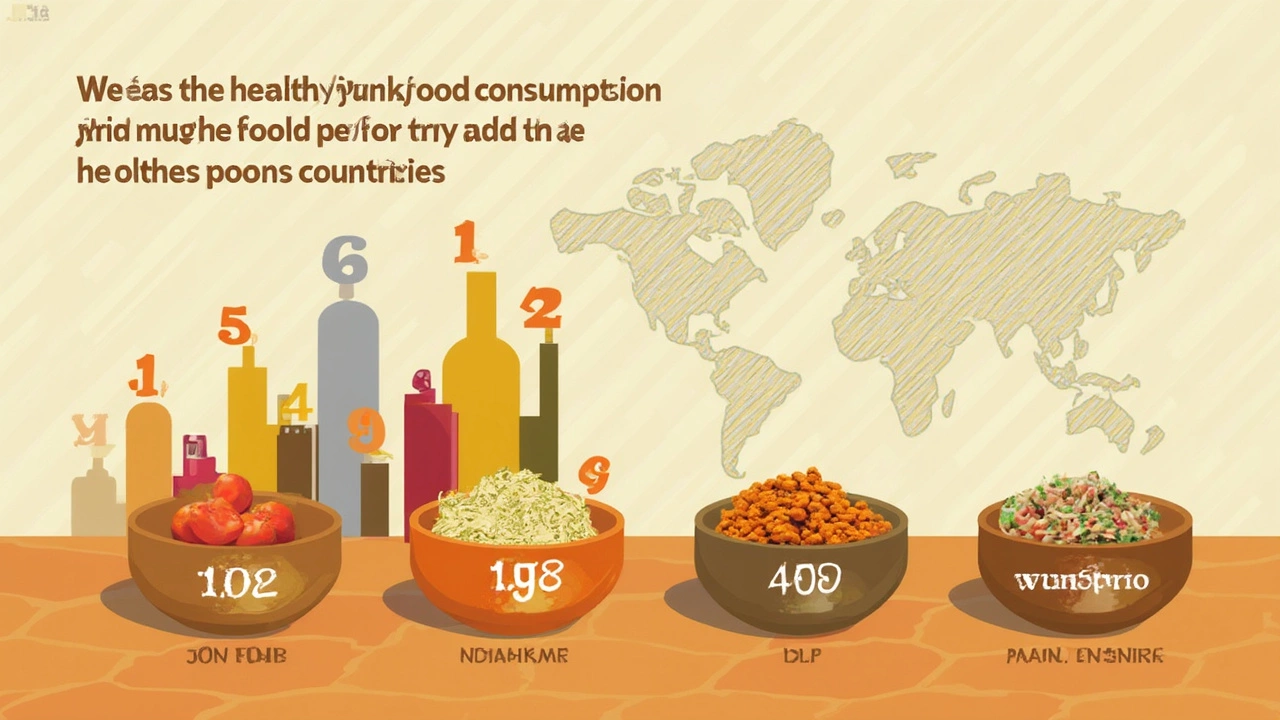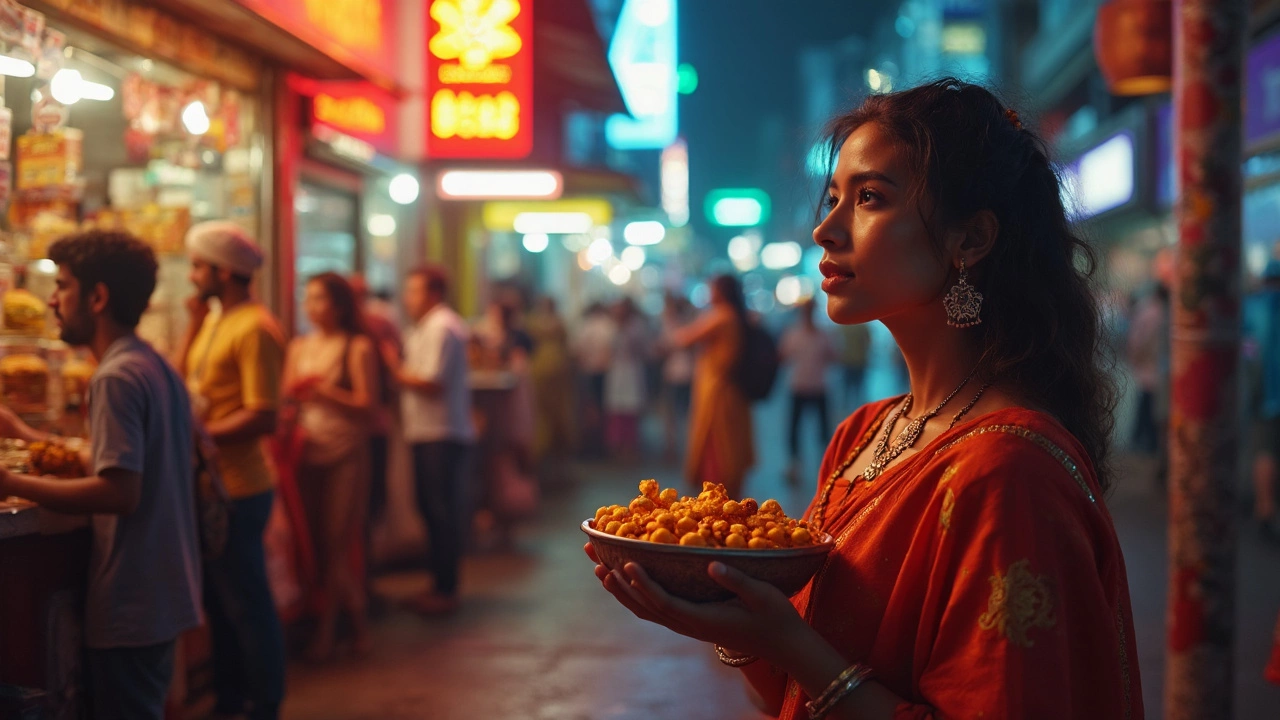Grab a bag of chips, and you might wonder if you’re making the same food choices as people elsewhere. Believe it or not, one country actually eats more junk food than anyone else. Americans, for example, spend over $110 billion a year on fast food. That's more than some countries spend on education. It’s not just fast food chains: sugary drinks, packaged snacks, and processed meals fill grocery carts in record numbers.
But here’s the kicker—eating like this isn’t just an American thing. The UK, Australia, and even parts of the Middle East aren’t too far behind. A major 2023 study ranked the US as the world leader in unhealthy food consumption, followed closely by the UK and Canada. These countries see higher obesity rates, more diabetes, and even heart problems starting in young people.
Why does this matter to someone interested in Indian snacks? Because junk food isn’t about geography—it’s about habits. Indian snacks have a reputation for being fried and sugary, but there’s a huge world of healthy twists out there. Ever tried roasted makhana (fox nuts) instead of popcorn, or spiced chana instead of potato chips? Swapping just one snack could sidestep a lot of regret later.
- The Worst Offenders: Who Tops the Junk Food List?
- How Eating Habits Shape Health
- Hidden Dangers on Your Plate
- Indian Snacks: Healthy Alternatives
- Simple Swaps for Everyday Eating
The Worst Offenders: Who Tops the Junk Food List?
If you had to guess which country eats the most junk food, you’d probably picture fast food chains at every corner and cola machines in every hallway. You wouldn’t be far off. The United States wears the crown when it comes to eating the most unhealthy food. According to data from the Centers for Disease Control and Prevention (CDC) in 2024, over 36% of Americans eat fast food every day. That’s not just burgers and fries—frozen pizzas, packaged cakes, and sugary soda are staples in American homes.
The UK follows right behind. British folks spend over £30 billion every year on fast food and ready meals. Soft drinks and crisps are popular, too. Nearly 40% of UK adults reported eating some kind of processed snack daily, according to a 2023 NHS survey.
Australia isn’t far down the list. A 2022 health report showed that more than one in three meals eaten by Aussies are considered ‘discretionary foods’—things like meat pies, chips, and sweet biscuits. In Canada, around 49% of daily calories in the average diet come from ultra-processed foods, says a government nutrition study.
To put the numbers in perspective, check out this simple table comparing how often people from these countries eat processed or fast foods:
| Country | % Fast/Processed Food Eaten Daily | Main Junk Food Types |
|---|---|---|
| United States | 36% | Burgers, Pizza, Soda |
| United Kingdom | 40% (processed snacks) | Ready Meals, Crisps, Chocolate |
| Australia | 33% | Meat Pies, Chips, Sweet Biscuits |
| Canada | 49% (calories from ultra-processed) | Frozen Meals, Packaged Desserts |
It’s not just about what people eat; it’s also how often. Kids in these countries are exposed to ads for junk food almost every time they turn on the TV or scroll online. No wonder fast food brands make billions each year. So while a lot of countries enjoy the occasional treat, the U.S., UK, Australia, and Canada bring a whole new meaning to the phrase "junk food nation."
When thinking about unhealthy food and its effects, these numbers are a good wakeup call. If your snacking habits have started to look a bit too much like the trend in these countries, it might be time to rethink your go-to munchies.
How Eating Habits Shape Health
What you eat doesn't just fill your belly—it actually rewires your body over time. In the US, the rise of processed foods full of sugar, salt, and unhealthy fats has gone hand in hand with record levels of obesity and diabetes. According to the CDC, nearly 42% of adults in America are now obese, a number that's doubled since the late 1980s. Fast food and ready-to-eat snacks have a lot to do with that.
These eating patterns affect way more than your waistline. The World Health Organization links high junk food diets with heart disease, high blood pressure, and even certain cancers. Researchers noticed that folks who eat a lot of packaged or fried snacks show higher cholesterol and blood sugar levels—even if they look healthy on the outside.
Eating habits are learned early, too. In countries that lead in unhealthy food consumption, kids get used to sugar-loaded breakfasts or salty snacks by age five. By the teen years, swapping fresh fruit for sweet cereals or candy is already the norm. This builds up risk factors for health problems decades before they appear.
- A diet high in processed snacks can mess with your digestion, making you feel bloated or sluggish.
- Regular junk food spikes your blood sugar, which increases your risk for type 2 diabetes.
- High amounts of sodium raise your blood pressure, putting extra stress on your heart.
- Skipping fiber-rich foods (like fruits, veggies, and whole grains) means you miss nutrients that protect your gut and strengthen immunity.
Not all hope is lost, though. Changing even one meal or snack each day can start to undo some of this damage. Real-world proof? People who switch from fast food to homemade, balanced meals cut their risk of heart problems in half within a few years. It’s really about daily choices, not just genetics or luck.

Hidden Dangers on Your Plate
A lot of foods look innocent, but they’re packed with stuff your body definitely doesn’t need. We’re talking about trans fats, sneaky sugars, huge amounts of salt, and chemicals to boost shelf life or color. It’s not just burgers or fries—some of these unhealthy ingredients hide out in things you might have at home, like ready-made sauces or packaged snacks.
Let’s look at real numbers. A 2023 survey by the World Health Organization found that people in the US get about unhealthy food calories from ultra-processed products: over 57% of their daily intake! Canadians and Brits scored almost as high. Processed foods make you feel full fast, but all those calories come without the vitamins, minerals, or fiber your body wants.
Check out this table showing what’s lurking in typical portions of popular junk foods:
| Food Item | Calories | Added Sugar (g) | Sodium (mg) | Trans Fats (g) |
|---|---|---|---|---|
| Fast Food Burger (1 medium) | 540 | 9 | 900 | 1.5 |
| Packaged Potato Chips (small bag) | 160 | 1 | 170 | 0.4 |
| Sugary Soda (355ml) | 150 | 39 | 45 | 0 |
| Candy Bar | 240 | 27 | 75 | 0.2 |
Doesn’t look like much? The trouble starts when you add up a few snacks in a day, every day. Suddenly, you’re way past healthy levels for salt, sugar, or unhealthy fats—and that triggers weight gain, spikes blood sugar, and raises your blood pressure. Even snacks labeled as “low-fat” or “sugar-free” can hide chemical additives and salt to make up for lost flavor.
If you really want to avoid these hidden dangers, flip the package over and check the label. Ingredients like “partially hydrogenated oils,” long chemical names, or anything ending in “-ose” (like fructose or glucose) are red flags. And if a snack has more than five ingredients you don’t recognize, it’s almost always a processed product you don’t need.
Indian Snacks: Healthy Alternatives
Most people think Indian snacks are all about deep-frying, but there’s way more to it. Some of the healthiest options are actually everyday staples in Indian kitchens. The cool part? These snacks can help curb cravings without loading up on calories or unhealthy fats.
Let’s start with healthy Indian snacks that are naturally high in protein or fiber, and low in the sugar and sodium you’ll find in junk food. Here are a few favorites to add to your snack list:
- Roasted chana (chickpeas): A 30g serving packs about 6g of protein and only 100 calories. These are filling and travel-friendly.
- Makhana (fox nuts): One cup has roughly 56 calories and almost no fat, making them a lighter swap for things like chips or crackers.
- Dhokla: This steamed snack is made from fermented batter, which adds probiotics and keeps fat low—great for gut health.
- Sprouted moong salad: A cup has over 13g of protein and tons of fiber, plus it’s easy to prep ahead.
- Homemade popcorn: Not technically Indian, but switch out butter and salt for a dash of chaat masala, and it becomes both fun and guilt-free.
You can see how these compare to regular junk food in the table below:
| Snack | Calories (per serving) | Protein (g) | Fat (g) | Sodium (mg) |
|---|---|---|---|---|
| Roasted Chana | 100 | 6 | 2 | 40 |
| Makhana | 56 | 2 | 0.5 | 30 |
| Dhokla | 90 | 5 | 2 | 180 |
| Sprouted Moong Salad | 110 | 13 | 0.7 | 50 |
| Packet Chips | 150 | 2 | 9 | 170 |
| Fried Samosa | 250 | 5 | 15 | 250 |
If you want to keep things healthy at snack time, just remember a few quick tips:
- Go for roasting or steaming instead of frying.
- Batch-cook snacks like chana, sprouts, or dhokla to save time and make good choices easier.
- Watch the salt—most packaged snacks are loaded with it. Use flavorful Indian spices instead (think cumin, chaat masala, or black salt).
Healthy snacks aren’t boring when you play with seasonings and textures. Plus, they’re better for your waistline and way lighter on your wallet than daily fast food runs.

Simple Swaps for Everyday Eating
If you’re tired of feeling sluggish after snack time, swapping out junk food for better options isn’t hard. The goal isn’t to give up snacks, but to pick ones that keep you full and satisfied—without wrecking your health.
Let’s get real with a few everyday examples. Love salty potato chips? Try roasted chana or makhana. Need something sweet? Dates stuffed with nuts are way better than sugary candy. These swaps aren’t just healthier—they often taste better and keep your energy up longer.
- Unhealthy food: Potato chips → Healthy swap: Roasted makhana or baked sweet potato chips
- Soda or sweetened drinks → Lemon water, buttermilk, or coconut water
- Packaged cookies → Whole grain crackers or homemade peanut chikki
- Crispy fried samosas → Steamed moong dal chilla with crunchy veggies
- Candy bars → Dates with almonds or homemade til (sesame) ladoos
Just switching up your go-to snacks can mean way less salt, sugar, and unhealthy fat for your body. Check out this table showing the difference:
| Snack | Calories (per serving) | Sugar (g) | Fat (g) | Fiber (g) |
|---|---|---|---|---|
| Potato chips | 150 | 0 | 10 | 1 |
| Roasted makhana | 90 | 0 | 2 | 3 |
| Sweet soda | 140 | 35 | 0 | 0 |
| Coconut water | 45 | 9 | 0 | 0 |
| Candy bar | 200 | 20 | 9 | 1 |
| Dates with almonds | 120 | 13 | 4 | 3 |
These numbers make it clear—smart swaps can add up to better health over time. Plus, Indian snacks like roasted chana or makhana aren’t just lower in bad stuff. They’re also easy to make and affordable. Keep a box of these at your desk or in your bag, and you’ll be less likely to grab something processed from the store.
